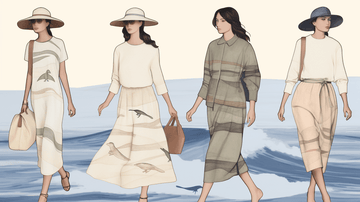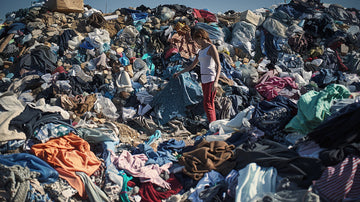Eco-Friendly Clothing vs Sustainable Clothing? What is the Difference?
by Lana Sands on Feb 10, 2024

Eco-friendly clothing: Also known as sustainable or green clothing, refers to garments that are produced using environmentally conscious practices throughout their entire lifecycle – from raw material sourcing to manufacturing, distribution, use, and disposal. The aim is to minimize the environmental impact associated with the fashion industry, which is known for its resource-intensive and often unsustainable practices.
Key characteristics of eco-friendly clothing include:
Sustainable Materials: Eco-friendly clothing often utilizes materials that have a lower environmental impact. This may include organic cotton, hemp, Tencel (lyocell), bamboo, recycled polyester, and other innovative fabrics produced using eco-friendly processes. For example: Sands Swim is made with 100% recycled Italian fabric. The fabric consists of recycled plastics pulled from the ocean made into the most chic luxurious recycled fabric, in our opinion, ever!
Ethical and Fair Labor Practices: Eco-friendly brands often prioritize fair and ethical labor practices. This includes providing safe working conditions, fair wages, and respecting workers' rights throughout the supply chain. The employees that helped produce Sands Swim garments are paid over minimum wage, are provided with a health insurance option and work in a safe and friendly environment.
Low Environmental Impact Production Processes: Sustainable clothing is manufactured using processes that minimize water usage, energy consumption, and pollution. Eco-friendly brands may employ technologies such as waterless dyeing, digital printing, and other environmentally responsible methods. For example: Sands Swim is what we call slow fashion. We do not have seasons or over produce. We cut small runs of clothing and chose to use a digital print, instead of a wet print. Wet prints wastewater and overuse water consumption. Not for us at Sands Swim, which is why we chose a digital print instead of a wet print.
Reduced Carbon Footprint: Brands producing eco-friendly clothing may strive to reduce their overall carbon footprint. This involves efforts to lower greenhouse gas emissions associated with production, transportation, and other aspects of the supply chain. Clients have the option of being emailed or text messaged their receipt for proof of purchase instead of given traditional receipt paper.
Closed-Loop Systems: Some eco-friendly clothing brands implement closed-loop systems, where materials are recycled or upcycled at the end of their life cycle. This reduces waste and encourages a circular economy. Again, Sands Swim is 100% recyclable material from Italy.
Transparency and Certification: Many eco-friendly brands are transparent about their sourcing and manufacturing processes. Some also seek third-party certifications, such as Global Organic Textile Standard (GOTS), OEKO-TEX, or Fair Trade, to validate their commitment to sustainability. Sands Swim is not only part of 1% for the Planet but the brick and mortar store, Sands Boutique is green certified.
Minimalist and Timeless Design: Eco-friendly clothing often focuses on timeless designs, promoting longevity and discouraging fast fashion trends. This approach encourages consumers to invest in quality, durable pieces that have a longer lifespan. We believe in environmentally conscious designs as well as quality and luxury clothing pieces.
Educational Initiatives: Some eco-friendly clothing brands engage in educational initiatives to raise awareness about sustainable fashion practices. This may include providing information on how to care for garments, encouraging responsible consumption, and promoting a more conscious approach to fashion. At Sands Boutique we try to spread awareness, the owner, Lana Sands, having worked at Goop, is a strong supporter of non-toxic beauty products, and eco-friendly, and sustainable clothing.
By choosing eco-friendly clothing, consumers can align their fashion choices with environmental and ethical values. This shift towards sustainability in the fashion industry is crucial for mitigating the negative impact of fast fashion and fostering a more environmentally responsible approach to clothing production.
Sustainable Clothing: Sustainable clothing refers to garments that are produced with a focus on minimizing environmental and social impacts throughout their entire life cycle. The aim of sustainable clothing is to promote responsible practices in the fashion industry, addressing issues related to resource depletion, pollution, and unethical labor practices. Sustainable clothing takes into consideration various factors, including raw materials, production processes, social responsibility, and end-of-life disposal.
Key aspects of sustainable clothing include:
Eco-Friendly Materials: Sustainable clothing often incorporates materials that have a lower environmental impact. This can include organic cotton, hemp, Tencel (lyocell), bamboo, recycled polyester, and other innovative fabrics produced using eco-friendly processes.
Ethical and Fair Labor Practices: Sustainable clothing brands prioritize fair and ethical treatment of workers throughout the supply chain. This includes ensuring safe working conditions, fair wages, and compliance with labor rights and regulations.
Low Environmental Impact Production: Sustainable clothing is manufactured using production processes that aim to minimize environmental harm. This may involve reducing water usage, energy consumption, and waste generation. Some brands invest in technologies like waterless dyeing or utilize renewable energy sources. For Sands Swim, we chose a digital print instead of a water print and Sands Boutique is committed to choosing brands with sustainable and eco-friendly practices.
Reduced Carbon Footprint: Sustainable clothing brands often strive to reduce their overall carbon footprint. This includes efforts to minimize greenhouse gas emissions associated with the production, transportation, and distribution of garments. For example: Sands Boutique is committed to being paperless in store, and when using paper it is recycled materials and packages.
Circular Economy Initiatives: Sustainable clothing encourages a circular economy by implementing closed-loop systems. This involves designing garments to be easily recyclable, up-cyclable, or biodegradable, reducing the amount of clothing that ends up in landfills. Brands we carry that are biodegradable, eco-friendly, and/or sustainable are Dick Moby, Outerknown, Sands Swim, Cleobella, Sophie Ratner, QUINN cashmere, Dr. Denim, Amsterdam Heritage and Ranger Station and Pirette.
Transparency and Certifications: Many sustainable clothing brands are transparent about their supply chain practices and may seek third-party certifications to validate their commitment to sustainability. Certifications such as Global Organic Textile Standard (GOTS), OEKO-TEX, or Fair Trade are examples of recognized standards in the industry.
Minimalist and Timeless Design: Sustainable fashion often focuses on timeless designs that resist trends, promoting longevity and discouraging fast fashion. This approach encourages consumers to invest in high-quality pieces with a longer lifespan.
Educational Initiatives: Some sustainable clothing brands engage in educational initiatives to raise awareness about responsible consumption. This may include providing information on garment care, promoting a conscious approach to fashion, and encouraging consumers to make informed choices.
The shift towards sustainable clothing reflects a growing awareness of the environmental and social impact of the fashion industry. Consumers who choose sustainable clothing contribute to a more ethical and environmentally responsible approach to fashion, helping to drive positive change in the industry.


